

Jcn.sagepub. 10. Search.proquest. 10. Cch. ?term=10. Ccp.sagepub. 10. Jad.sagepub. Preventive Interventions for ADHD: A Neurodevelopmental Perspective. Jcpp. Rates of ADHD Are Skyrocketing, But That’s a Good Thing. The number of children diagnosed with attention deficit hyperactivity disorder (ADHD) rose by 43 percent between 2003 and 2011.
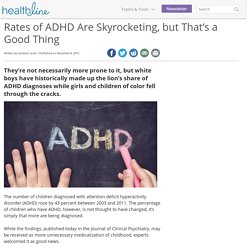
The percentage of children who have ADHD, however, is not thought to have changed, it’s simply that more are being diagnosed. While the findings, published today in the Journal of Clinical Psychiatry, may be received as more unnecessary medicalization of childhood, experts welcomed it as good news. “Part of the problem with ADHD is that there’s a lot of misinformation, so some people would look at that and say we’re just diagnosing too many kids,” said Dr. Mark Wolraich, chief of the developmental and behavioral pediatrics section at the University of Oklahoma Health Sciences Center and a spokesman for the American Academy of Pediatrics.
“I see that some of it is encouraging in many kids who have been under-diagnosed in the past may now be getting diagnosed.” It may be true that doctors have diagnosed ADHD too liberally. Putting Treatment Within Reach. Telling good from bad news: ADHD differentially affects processing of positive and negative feedback during guessing. A Department of Clinical Neuropsychology, Vrije Universiteit Amsterdam, Van der Boechorststraat 1, 1081 BT Amsterdam, The Netherlandsb Department of Cognitive Psychology, Vrije Universiteit Amsterdam, Van der Boechorststraat 1, 1081 BT Amsterdam, The Netherlands Received 24 September 2004, Revised 18 February 2005, Accepted 2 March 2005, Available online 4 May 2005 Choose an option to locate/access this article: Check if you have access through your login credentials or your institution Check access Get rights and content Abstract Neuroimaging studies on ADHD suggest abnormalities in brain regions associated with decision-making and reward processing such as the anterior cingulate cortex (ACC) and orbitofrontal cortex.

Keywords ERP; Decision making; Reward; Error-related negativity; ACC; Reinforcement Copyright © 2005 Elsevier Ltd. Received 24 September 2004, Revised 18 February 2005, Accepted 2 March 2005, Available online 4 May 2005 Choose an option to locate/access this article: Check access. ADHD Epidemiology - Prevalence & geographical factors. Although there is no global consensus on the prevalence of attention-deficit hyperactivity disorder (ADHD) in children, adolescents and/or adults, meta-regression analyses have estimated the worldwide prevalence at between 5.29%1 and 7.1% in children and adolescents,2 and at 3.4% (range 1.2–7.3%) in adults.3 The prevalence of ADHD in very young children (aged <6 years) or later in adult life (aged >44 years), is less well-studied.2 Prevalence factors ADHD prevalence rates may vary depending on several factors: Age – whilst ADHD was once considered to be a childhood disease with a decline in symptoms during maturation to adulthood,4 it is now acknowledged to persist into adulthood in an estimated 50–66% of individuals5-8Gender – a higher prevalence of ADHD is often reported in males2,9,10 Presentations of ADHD – the combined inattentive-hyperactive-impulsive presentation of ADHD is considered most prevalent in children, adolescents and adults.2,11,12 Geographical location Share.
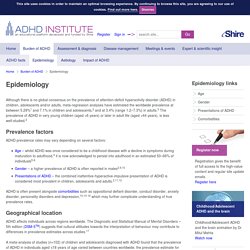
NIMH » Science News About Attention Deficit Hyperactivity Disorder (ADHD) Prescribed stimulant use for ADHD continues to rise steadily • Press Release The prescribed use of stimulant medications to treat attention deficit hyperactivity disorder (ADHD) rose slowly but steadily from 1996 to 2008, according to a study conducted by the National Institutes of Health (NIH) and the Agency for Healthcare Research and Quality (AHRQ).
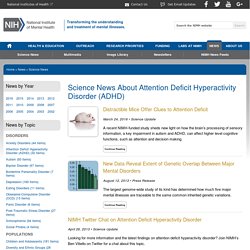
Continue Reading. Nice.org. Results from the largest treatment study of ADHD ever conducted. Over the past year you may have seen preliminary reports of results from the Multimodal Treatment Study of Children with ADHD (MTA).
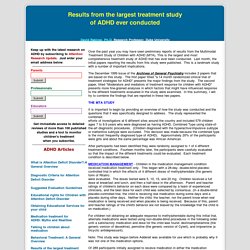
This is the largest and most comprehensive treatment study of ADHD that has ever been conducted. Last month, the initial papers reporting the results from this study were published. This is a landmark study with a number of important implications. The December 1999 issue of the Archives of General Psychiatry includes 2 papers that are based on this study. The first paper titled "a 14 month randomized clinical trial of treatment strategies for ADHD" presents the major findings from the study. It is important to begin by providing an overview of how the study was conducted and the questions that it was specifically designed to address. After participants had been identified they were randomly assigned to 1 of 4 different treatment conditions.
MEDICATION MANAGEMENT - Children in the medication management condition received medication treatment only. 1. 2. 3. ADHD, Facts - NCBDDD. ADHD is one of the most common neurodevelopmental disorders of childhood.
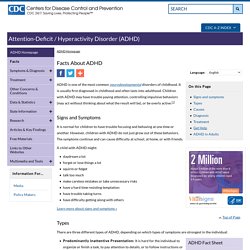
It is usually first diagnosed in childhood and often lasts into adulthood. Children with ADHD may have trouble paying attention, controlling impulsive behaviors (may act without thinking about what the result will be), or be overly active.[1( Signs and Symptoms It is normal for children to have trouble focusing and behaving at one time or another. 931.full.